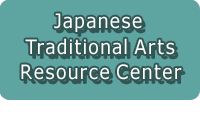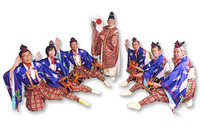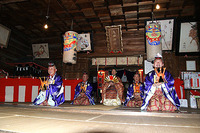

Total:35items
- Folk Performing Art (16)
- Kenbai: Sword Dance
- Kirin Shishimai: Kylin Lion Dance
- Yoshiwa Taiko Odori: Yoshiwa Drum Dance
- Omiya Odori: Omiya Dance
- Tsurusaki-Odori festival
- Omi Take-no-karakai (Tug-of-wars with bamboo)
- Nakizumo: Crying Baby Sumo
- Ryugasaki Tsukumai:Ryugasaki Acrobatic Performance
- Mikawa Manzai
- Esashi Oiwake: Esashi Folk Singing
- Ayado Yonenbutsu and Bon festival dance
- Occhi-no-Ohinagayu (rice porridge offering for the Doll's Festival in Occhi)
- Hanatori-odori Dance (Masuda area)
- Kaga-manzai
- Rice Planting festival of Tsutsukowake Shrine
- Edo sato kagura: Edo folk dance for entertaining god
- Kabuki (2)
- Noh & Kyogen (1)
- Festival (10)
- Ritual & Ceremony (2)
- Puppet Play (2)
- Folk technology (2)

 |
|
 《Feature》
《Feature》Mikawa Manzai is a kind of Manzai performance. Manzai is a celebration performance in which Tayu (a performer of Shinto ritual) wearing Eboshi (a kind of hat handed down from 9c in Japan) and Suou (a kind of traditional clothes composed of upper and lower parts) sings auspicious words while dancing along with the sound of Saizo (a role in the performance) 's Tsuzumi drum. It is said that auspicious words sung by Tayu will come true. The old Manzai we know is Senzu Manzai of 800 years ago, which was performed in the imperial court in Kyoto by shamans from Yamato-no-kuni (Nara prefecture in present days)
The history of Mikawa Manzai started in around 15-16c when Japan was in the Warring-States period. In those days,it was a prayer for victory performed by a shaman coming from Bessho (present Higashibessho-cho and Nishibessho-cho in Anjo City of West Mikawa area)in Anshoujou castle (located in present Anjo-cho) owned by Matsudaira family (the ancestor of Tokugawa family) . The style gradually changed, and in the era of Tokugawa Ieyasu, the ceremony started to be called "Mai-mai", as a shaman also danced while telling a story.
From around 17c, shamans in Mikawa (east part of present Aichi Pref.) began to travel to Edo (the central part of present Tokyo) at the beginning of the year to offer prayers to people who had relationships with Mikawa. The contents of prayers gradually changed following the Manzai style of the imperial court and it became popular among samurai families as "Mikawa Manzai", named after the hometown of shamans. Unlike the popular Manzai style in the late Edo period (17-19c), which was performed at the gate or at the entrance hall of each house,the characteristic of Mikawa Manzai was to be performed inside the house, known as "Zashiki Manzai,"
However, when the Meiji government began to focus on modernization in the late 19c, ancient fortune telling and prayers were banned. . Thus, Manzai prayers in Mikawa followed the Shintoistic style which the then government recommended, and changed the words of prayers and costumes to those of Shinto priests.
Mikawa Manzai in Anjo, one of the variations of Mikawa Manzai, can be divided into three programs:
1. Shinto Mikawa Manzai: Performed by Tayu and Saizo
This program consists of three parts: "Dance of Three Cranes", "Dance of Seven Herbs", and "Dance of Opening Amano-Iwato (a cave which appears in Shinto myth)".. This comical dance with auspicious words such as crane, turtle, shrimp, carp, prosperity, abundance attracts attention for its archaic style. This program has been passed down from the one in Bessho, which is performed by Tayu and Saizo.
2. Mikawa Goten Manzai: Performed on stage, with Tayu holding a fan in the center and 2 to 3 Saizos on each side of Tayu
This performance proceeds with a song about the arrival of a crane and a turtle at the New Year In the song, they call gods to the pillars of a house, followed by the arrival of seven deities of good luck and celebration. Tayu with a fan in his hand and Saizo with Tsuzumi perform with a smile on their face, saying many auspicious words rhythmically. In the first part, Tayu keep sitting on a stool and Saizo sits down. Then in the latter half of the performance, they stand and dance while singing.
3. Sankyoku Manzai: Comical play about famous scenes in Kabuki play, performed with music by tsuzumi, samisen (a kind of Japanese guitar), and koto (a kind of Japanese harp)
This program is performed with comical words and movements based on famous scenes in Kabuki. The name 'Sankyoku Manzai' means a manzai with three instruments. It was also called 'Shibai Manzai' (Drama Manzai) and was very popular.
[A national Important Intangible Folk Cultural Property]
Provided by: The Office of the Supporters' Association of Anjo-no-Mikawa-Manzai
Translation: Aki Tobayama, reviewed by Marina Izumi
| Location | In the early spring, it can be seen at shrines or Anjo City Museum of History. Please call the following number for more detailed information. |
|---|---|
| Contact | The Office of the Supporters' Association of Anjo-no-Mikawa-Manzai (located in Anjo City Museum of History)
(Tel:) 0566(77)6655 (Fax:) 0566(77)6600 (Japanese only) |
| Highlight/POI | The history of Mikawa Manzai in Anjo dates back to the pre-war era.
In Anjo , Manzais coming from Owari (west part of present Aichi Pref. ) were also performed in Enokimae-cho and Fukama-cho area in addition to the one of Bessho style. After World War 2, with the declining popularity of Manzai in Bessho, Manzai in those two areas flourished and they came to be known as Manzai in Anjyo. A preservation association was established to transmit Mikawa Manzai to posterity, which enabled the inheritance of traditional Bessho Mikawa Manzai. |
| General Participation | Anjo City Museum of History 300 Shirobori, Anjo-cho, Anjo City, Aichi Prefecture
(Tel:) 0566(77)6655 (Fax:) 0566(77)6600 (Japanese only) Assistance needed? For inquiries in English: JTCO Contact Form Your inquiries will be forwarded by JTCO in Japanese to the organization you wish to contact. |
| URL | http://anjomikawamanzai.sakura.ne.jp/index.html |



